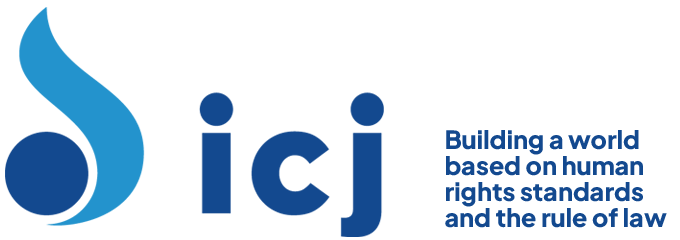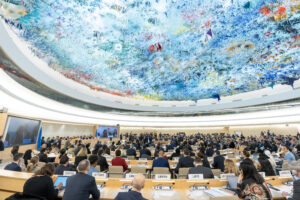III. Obligations of States regarding sport and healthy lifestyles and the right to health
Respect
16. The obligation to respect the right to health by refraining from denying or limiting access to health services and by abstaining from enforcing discriminatory practices as a State policy extends to participation in sport and physical activity. All people should be permitted to access State-run sporting facilities on an equal basis. Discrimination in access on grounds such as gender, race, ethnicity, religion, sexual orientation, gender identity, sex characteristics, or legal and health status (including HIV/AIDS status) is not permissible. States should conduct an inclusive, participatory and transparent audit of practices, rules and by-laws relating to sport and the right to health in order to determine their compatibility with human rights standards and should remove any which are discriminatory.
IV. Sport and healthy lifestyles and the right to health of key populations and groups
B. Lesbian, gay, bisexual, transgender and intersex people
50. Historically, sport has often involved forms of “hegemonic masculinity”: boys and men have frequently been enabled or encouraged to exhibit aggressive, violent or discriminatory behaviour in competitive sport, including sexism, misogyny, homophobia and transphobia.{{40}} A welcome shift in this paradigm has occurred in a number of regions and countries where homophobia has decreased, where this has included the area of sports. Nevertheless, levels of homophobia, transphobia, and discrimination against intersex people remain high in most countries. Those who are perceived to fall outside dominant gender and heteronormative standards, including lesbian, gay, bisexual, transgender and intersex people, continue to face discriminatory treatment and restrictions in sport, including discrimination, harassment and violence, and a lack of safe and welcoming spaces for participation.
51. Numerous issues arise in respect of persons who are lesbian, gay or bisexual in the context of sport. In a recent six-country survey, 80 per cent of respondents reported having witnessed or experienced homophobia in sport, and nearly 20 per cent of gay men reported having been assaulted during sports activities.{{41}} In certain jurisdictions, lesbian athletes have been harassed and subjected to violence, including “corrective rape”, on the basis of their sexual orientation.
52. Acts of violence, discrimination and marginalization represent human rights breaches that prevent individuals from achieving the highest attainable standard of health. More must be done to secure the full and safe participation of lesbian, gay and bisexual people in sport and physical activity. States should decriminalize homosexuality and repeal other laws used to arrest and punish individuals on the basis of their sexual orientation, and should protect individuals by implementing and enforcing anti-discrimination laws,{{42}} including in sport.
53. Moreover, sex segregation policies have led to multiple rights violations in sport. Sex segregation has historically been justified on the basis of safety and fairness, rooted in assumptions of male physical superiority. Various legal decisions have noted that this is a generalization and have granted individual girls and women the right to compete in male sporting competitions — although not vice versa.{{43}} Although it is important to preserve spaces for girls and women to confidently participate in sport, this should not result in exclusion of others, such as transgender people.
54. States should identify groups that are currently excluded from sport and physical activity, and through participatory mechanisms, create an inclusive culture wherein lesbian, gay, bisexual, transgender and intersex people and other historically excluded groups and individuals can fully and safely participate in sport.
Intersex people
55. Current and historic policies have resulted in intersex people — those born with sex characteristics that do not fit with typical binary sex categorization — experiencing multiple rights violations. Sex testing has frequently been conducted to avoid the apparent threat of “sex fraud” (participating under an assumed gender to obtain a competitive advantage).{{44}} However, no single test “determines” gender. In the recent past, women athletes have undergone chromosomal testing, only to discover that they do not possess two X chromosomes. This has led to stigmatization and to spurious exclusion from competitive sport.{{45}}
56. Recently, certain international and national sporting federations have instead introduced policies banning women with testosterone levels exceeding a certain threshold from participating in competitive sport. However, there is insufficient clinical evidence to establish that those women are afforded a “substantial performance advantage” warranting exclusion.{{46}} Although currently suspended, following the interim judgement in Chand v. Athletics Federation of India and the International Association of Athletics Federations,{{47}} these policies have led to women athletes being discriminated against and forced or coerced into “treatment” for hyperandrogenism. In fact, a number of athletes have undergone gonadectomy (removal of reproductive organs) and partial cliteroidectomy (a form of female genital mutilation){{48}} in the absence of symptoms or health issues warranting those procedures.{{49}}
57. Sporting organizations must implement policies in accordance with human rights norms and refrain from introducing policies that force, coerce or otherwise pressure women athletes into undergoing unnecessary, irreversible and harmful medical procedures in order to participate as women in competitive sport. States should also adopt legislation incorporating international human rights standards to protect the rights of intersex persons at all levels of sport, given that they frequently report bullying and discriminatory behaviour,{{50}} and should take steps to protect the health rights of intersex women in their jurisdiction from interference by third parties.
Transgender people
58. Participation in professional sport is often deliberately or effectively denied to transgender people, and people of non-binary gender. There remains uncertainty regarding “classification” by sports bodies of persons as male or female within sex-segregated sport — for those undergoing gender transition through clinical treatment and for those who are not — as well as concerns with regard to the arbitrary nature of such classifications. The barriers that this presents to participation are unwarranted and unfair.
59. Encouragingly, the recent consensus statement of the International Olympic Committee on sex reassignment and hyperandrogenism addresses this issue. However, consensus should be reached among all international sporting bodies and national governments, in consultation with transgender organizations, on participation by transgender people and non-binary people in sporting competitions. Policies must reflect international human rights norms, should not exclude transgender people and non-binary people from participation and should not require irrelevant clinical data or unnecessary medical procedures as a precondition to full participation.
60. At the amateur level, sporting facilities and teams can be hostile spaces for transgender athletes, including non-binary people. Barriers include poorly designed changing rooms, requirements to wear clothing that might cause individual discomfort or hinder bodily movement, and restrictions on the use of sex-segregated bathrooms.
61. The repeal of laws criminalizing transgender people on the basis of their gender identity or expression, and the legal recognition of gender identity based on self- identification (without abusive requirements) is a prerequisite for transgender people to access sports and enjoy healthy lifestyles. States, sporting organizations and other actors should adopt anti-discrimination policies that permit all persons to participate in amateur sport on the basis of their self-identified gender. Practical steps to create welcoming spaces for participation in sport and physical activity for transgender people and non-binary people could include the installation of appropriate changing rooms, the sensitization of sporting communities, and the enforcement of anti-discrimination laws in the sporting context.
V. Conclusions and recommendations
101. The Special Rapporteur recommends that States:
(g) Review legislation and adopt policies to ensure that all persons, including women, lesbian, gay, bisexual, transgender and intersex people, people living with disabilities, children, the elderly and other populations that are underserved or face discrimination, are able to participate in and safely enjoy sports;
(i) Protect the physical integrity and dignity of all athletes, including intersex and transgender women athletes, and immediately remove any laws, policies and programmes that restrict their participation or otherwise discriminate or require them to undergo intrusive, unnecessary medical examinations, testing and/or procedures in order to participate in sport;
102. The Special Rapporteur recommends that national human rights institutions, non-State actors and sporting bodies:
(b) Reach consensus on policies allowing for unhindered participation in high-level competitive and amateur sport by transgender and intersex people (international sporting bodies);
(c) Remove any policies that require women athletes, including intersex and transgender women athletes, to undergo unnecessary medical procedures in order to participate in competitive sport (international sporting bodies);
Link to full text of the report: report-srhealth-sport-2016-eng
[[40]]40. Jennifer Hargreaves and Eric Anderson, eds., Routledge Handbook of Sport, Gender and Sexuality (Oxford, Routledge, 2014).[[40]]
[[41]]41.Erik Denison and Alistair Kitchen, Out On The Fields: The First International Study on Homophobia in Sport (2015).[[41]]
[[42]]42. Paulo David, Human Rights in Youth Sport.[[42]]
[[43]]43. Erin Buzuvis, “Transgender student-athletes and sex-segregated sport: developing policies of inclusion for intercollegiate and interscholastic athletics”, Seton Hall Journal of Sports and Entertainment Law, vol. 21, No. 1 (2011).[[43]]
[[44]]44. J.C. Reeser, “Gender identity and sport: is the playing field level?” British Journal of Sports Medicine, vol. 39, No. 10.[[44]]
[[45]]45. Erin Buzuvis, “Transgender student-athletes…”[[45]]
[[46]]46. J.C. Reeser, “Gender identity and sport: is the playing field level?”[[46]]
[[47]]47. CAS 2014/A/3759, Court of Arbitration for Sport.[[47]]
[[48]]48. J.C. Reeser, “Gender identity and sport: is the playing field level?”[[48]]
[[49]]49. Rebecca Jordan-Young, Peter Sönksen and Katrina Karkazis, “Sex, health and athletes”, British Medical Journal, vol. 348.[[49]]
[[50]]50. Tiffany Jones and others, Intersex: Stories and Statistics from Australia (Open Book Publishers, 2016).[[50]]




